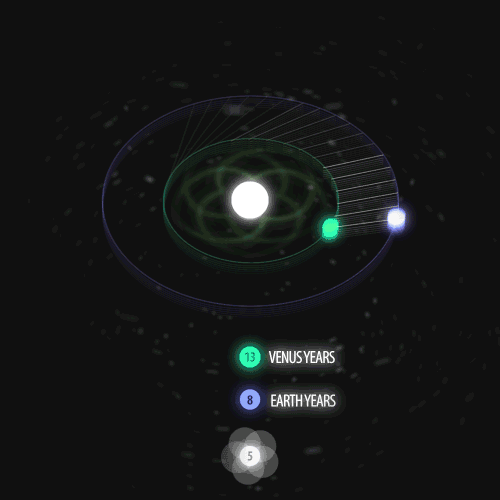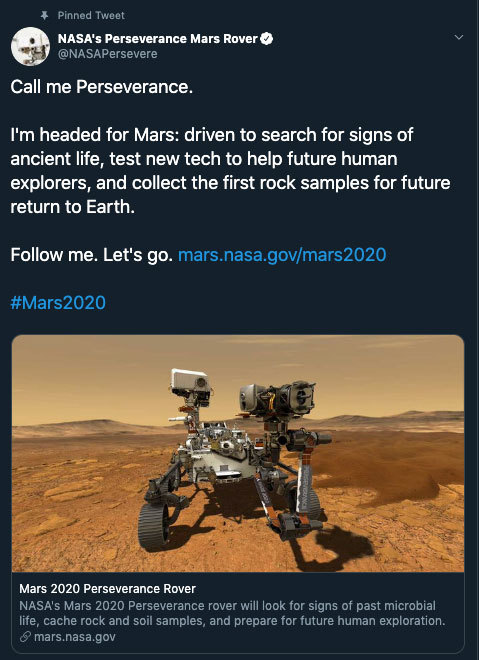Planetary Kiss, Coming To A Sky Near You On 21 Dec. (image: Pete Lawrence) Https://www.instagram.com/p/CIdav8cnXYN/?igshid=1tjshkkdl24f4

Planetary Kiss, coming to a sky near you on 21 Dec. (image: Pete Lawrence) https://www.instagram.com/p/CIdav8cnXYN/?igshid=1tjshkkdl24f4
More Posts from Fillthevoid-with-space and Others
Does Mars Have Rings? Not Right Now, But Maybe One Day
NASA - Mars Science Laboratory (MSL) patch. March 20, 2017 As children, we learned about our solar system’s planets by certain characteristics – Jupiter is the largest, Saturn has rings, Mercury is closest to the sun. Mars is red, but it’s possible that one of our closest neighbors also had rings at one point and may have them again someday. That’s the theory put forth by NASA-funded scientists at Purdue University, Lafayette, Indiana, whose findings were published in the journal Nature Geoscience. David Minton and Andrew Hesselbrock developed a model that suggests that debris that was pushed into space from an asteroid or other body slamming into Mars around 4.3 billion years ago alternates between becoming a planetary ring and clumping together to form a moon. One theory suggests that Mars’ large North Polar Basin or Borealis Basin – which covers about 40 percent of the planet in its northern hemisphere – was created by that impact, sending debris into space. “That large impact would have blasted enough material off the surface of Mars to form a ring,” Hesselbrock said. Hesselbrock and Minton’s model suggests that as the ring formed, and the debris slowly moved away from the Red Planet and spread out, it began to clump and eventually formed a moon. Over time, Mars’ gravitational pull would have pulled that moon toward the planet until it reached the Roche limit, the distance within which a planet’s tidal forces will break apart a celestial body that is held together only by gravity.
Image above: The image from NASA’s Curiosity Mars rover shows one of Mars’ two moons, Phobos, passing directly in front of the other, Deimos, in 2013. New research suggests the moons consolidated long ago from dust rings around the planet and, in the distant future, may disintegrate into new rings. Image Credits: NASA/JPL-Caltech/Malin Space Science Systems/Texas A&M Univ. Phobos, one of Mars’ moons, is getting closer to the planet. According to the model, Phobos will break apart upon reaching the Roche limit, and become a set of rings in roughly 70 million years. Depending on where the Roche limit is, Minton and Hesselbrock believe this cycle may have repeated between three and seven times over billions of years. Each time a moon broke apart and reformed from the resulting ring, its successor moon would be five times smaller than the last, according to the model, and debris would have rained down on the planet, possibly explaining enigmatic sedimentary deposits found near Mars’ equator. “You could have had kilometer-thick piles of moon sediment raining down on Mars in the early parts of the planet’s history, and there are enigmatic sedimentary deposits on Mars with no explanation as to how they got there,” Minton said. “And now it’s possible to study that material.” Other theories suggest that the impact with Mars that created the North Polar Basin led to the formation of Phobos 4.3 billion years ago, but Minton said it’s unlikely the moon could have lasted all that time. Also, Phobos would have had to form far from Mars and would have had to cross through the resonance of Deimos, the outer of Mars’ two moons. Resonance occurs when two moons exert gravitational influence on each other in a repeated periodic basis, as major moons of Jupiter do. By passing through its resonance, Phobos would have altered Deimos’ orbit. But Deimos’ orbit is within one degree of Mars’ equator, suggesting Phobos has had no effect on Deimos. “Not much has happened to Deimos’ orbit since it formed,” Minton said. “Phobos passing through these resonances would have changed that.” “This research highlights even more ways that major impacts can affect a planetary body,” said Richard Zurek of NASA’s Jet Propulsion Laboratory, Pasadena, California. He is the project scientist for NASA’s Mars Reconnaissance Orbiter, whose gravity mapping provided support for the hypothesis that the northern lowlands were formed by a massive impact. Minton and Hesselbrock will now focus their work on either the dynamics of the first set of rings that formed or the materials that have rained down on Mars from disintegration of moons. Curiosity is part of NASA’s ongoing Mars research and preparation for a human mission to Mars in the 2030s. Caltech manages JPL, and JPL manages the Curiosity mission for NASA’s Science Mission Directorate in Washington. For more about Curiosity, visit: http://www.nasa.gov/msl and http://mars.jpl.nasa.gov/msl/ For more information about NASA missions investigating Mars, visit: https://mars.nasa.gov/ Image (mentioned), Text, Credits: NASA/Laurie Cantillo/Dwayne Brown/JPL/Guy Webster/Purdue University/Steve Tally/Emil Venere/Writer: Brian Wallheimer. Best regards, Orbiter.ch Full article
The Beauty of Webb Telescope’s Mirrors
The James Webb Space Telescope’s gold-plated, beryllium mirrors are beautiful feats of engineering. From the 18 hexagonal primary mirror segments, to the perfectly circular secondary mirror, and even the slightly trapezoidal tertiary mirror and the intricate fine-steering mirror, each reflector went through a rigorous refinement process before it was ready to mount on the telescope. This flawless formation process was critical for Webb, which will use the mirrors to peer far back in time to capture the light from the first stars and galaxies.

The James Webb Space Telescope, or Webb, is our upcoming infrared space observatory, which will launch in 2019. It will spy the first luminous objects that formed in the universe and shed light on how galaxies evolve, how stars and planetary systems are born, and how life could form on other planets.
A polish and shine that would make your car jealous

All of the Webb telescope’s mirrors were polished to accuracies of approximately one millionth of an inch. The beryllium mirrors were polished at room temperature with slight imperfections, so as they change shape ever so slightly while cooling to their operating temperatures in space, they achieve their perfect shape for operations.

The Midas touch
Engineers used a process called vacuum vapor deposition to coat Webb’s mirrors with an ultra-thin layer of gold. Each mirror only required about 3 grams (about 0.11 ounces) of gold. It only took about a golf ball-sized amount of gold to paint the entire main mirror!

Before the deposition process began, engineers had to be absolutely sure the mirror surfaces were free from contaminants.

The engineers thoroughly wiped down each mirror, then checked it in low light conditions to ensure there was no residue on the surface.

Inside the vacuum deposition chamber, the tiny amount of gold is turned into a vapor and deposited to cover the entire surface of each mirror.

Primary, secondary, and tertiary mirrors, oh my!
Each of Webb’s primary mirror segments is hexagonally shaped. The entire 6.5-meter (21.3-foot) primary mirror is slightly curved (concave), so each approximately 1.3-meter (4.3-foot) piece has a slight curve to it.

Those curves repeat themselves among the segments, so there are only three different shapes — 6 of each type. In the image below, those different shapes are labeled as A, B, and C.

Webb’s perfectly circular secondary mirror captures light from the 18 primary mirror segments and relays those images to the telescope’s tertiary mirror.

The secondary mirror is convex, so the reflective surface bulges toward a light source. It looks much like a curved mirror that you see on the wall near the exit of a parking garage that lets motorists see around a corner.

Webb’s trapezoidal tertiary mirror captures light from the secondary mirror and relays it to the fine-steering mirror and science instruments. The tertiary mirror sits at the center of the telescope’s primary mirror. The tertiary mirror is the only fixed mirror in the system — all of the other mirrors align to it.

All of the mirrors working together will provide Webb with the most advanced infrared vision of any space observatory we’ve ever launched!
Who is the fairest of them all?
The beauty of Webb’s primary mirror was apparent as it rotated past a cleanroom observation window at our Goddard Space Flight Center in Greenbelt, Maryland. If you look closely in the reflection, you will see none other than James Webb Space Telescope senior project scientist and Nobel Laureate John Mather!

Learn more about the James Webb Space Telescope HERE, or follow the mission on Facebook, Twitter and Instagram.
Make sure to follow us on Tumblr for your regular dose of space: http://nasa.tumblr.com.
September 15
This one is technically not yet history, because at the time of posting, the little craft has about half an hour left to go. That said, let’s proceed.
In 2017, NASA’s Cassini space probe ended its twenty-year mission at Saturn. After a nearly-seven-year-long journey there, it orbited the ringed planet for 13 years and just over two months, gathering copious amounts of information about the planet, said rings, and many of its moons. It landed an ESA probe called Huygens on Titan, the first-ever soft landing in the outer Solar System. It discovered lakes, seas, and rivers of methane on Titan, geysers of water erupting from Enceladus (and passed within 50 miles of that moon’s surface), and found gigantic, raging hurricanes at both of Saturn’s poles.
And the images it returned are beautiful enough to make you weep.
On this day in 2017, with the fuel for Cassini’s directional thrusters running low, the probe was de-orbited into the Saturnian atmosphere to prevent any possibility of any contamination of possible biotic environments on Titan or Enceladus. The remaining thruster fuel was used to keep the radio dish pointed towards Earth so the probe could transmit information about the upper atmosphere of Saturn while it was burning up due to atmospheric friction.
This is us at our best. We spent no small amount of money on a nuclear-powered robot, launched it into space, sent it a billion miles away, and worked with it for two decades just to learn about another planet. And when the repeatedly-extended missions were through, we made the little craft sacrifice itself like a samurai, performing its duty as long as it could while it became a shooting star in the Saturnian sky.

Rhea occulting Saturn

Water geysers on Enceladus

Strange Iapetus

Look at this gorgeousness

A gigantic motherfucking storm in Saturn’s northern hemisphere

Tethys

This image is from the surface of a moon of a planet at least 746 million miles away. Sweet lord

Mimas

Vertical structures in the rings. Holy shit

Titan and Dione occulting Saturn, rings visible

Little Daphnis making gravitational ripples in the rings

That’s here. That’s home. That’s all of us that ever lived.

Saturn, backlit

A polar vortex on the gas giant

Icy Enceladus
(All images from NASA/JPL)
Here’s the nose scratching sponge I talked about in Episode 19!

This is how astronauts clear our ears (and scratch our noses!) during a spacewalk.





Fibonacci you crazy bastard….
As seen in the solar system (by no ridiculous coincidence), Earth orbits the Sun 8 times in the same period that Venus orbits the Sun 13 times! Drawing a line between Earth & Venus every week results in a spectacular FIVE side symmetry!!
Lets bring up those Fibonacci numbers again: 1, 1, 2, 3, 5, 8, 13, 21, 34..
So if we imagine planets with Fibonacci orbits, do they create Fibonacci symmetries?!
You bet!! Depicted here is a:
2 sided symmetry (5 orbits x 3 orbits)
3 sided symmetry (8 orbits x 5 orbits)
5 sided symmetry (13 orbits x 8 orbits) - like Earth & Venus
8 sided symmetry (21 orbits x 13 orbits)
I wonder if relationships like this exist somewhere in the universe….
Read the Book | Follow | Hi-Res -2- -3- -5- -8-

Did you know that some observatories are not on the ground and not orbiting Earth, but are mounted on airplanes? I finally researched SOFIA, an infrared observatory in a repurposed plane, and discovered there’s a rich history of airborne astronomy. And by airborne astronomy, I mean a lot of people took pictures of astronomical phenomena from planes!
Below the cut, I have the glossary, transcript, sources, and music credits. If you have suggestions for topics I could cover, please send me a Tumblr message or tweet at me on Twitter at @HDandtheVoid, or you can ask me to my face if you know me. Please subscribe on iTunes, rate my podcast and maybe review it, and tell friends if you think they’d like to hear it!
(My thoughts on the next episode are Chuck Yeager, Stephen Hawking and his theories, the opposition of Mars, famous comets, recent developments and discoveries in the astronomer community, or an atmospheric phenomenon called ‘Steve.’ The next episode will go up April 30th, lord willing and the creek don’t rise!)
Glossary
absorption bands - the areas of the electromagnetic spectrum that are absorbed by atmospheric gases.
atmospheric windows - the areas of the electromagnetic spectrum where the atmosphere is transparent, or does not absorb the radiation of specific wavelengths.
corona - the hot outer atmosphere of the Sun.
electromagnetic spectrum - the range of wavelengths or frequencies over which electromagnetic radiation extends. A photon transmits electromagnetic radiation at different frequencies, which are in a range that includes (from highest frequency to lowest) gamma rays, X-rays, ultraviolet light, visible light, infrared, microwaves, and radio waves
frequency - the number of times a wave oscillates up and down per second.
hypoxia - insufficient oxygen in the blood. Symptoms include vertigo, nausea, weakness, hyperventilation, slowed thinking, poor coordination, dimmed vision, and increased heart rate.
photon - a type of elementary particle that moves in a wave. It transmits electromagnetic radition such as light. The more energy a photon has, the higher its frequency.
Script/Transcript
Sources
A map of every active satellite orbiting Earth via Quartz
Infrared radiation via Gemini Observatory (Feb 1999)
Absorption Bands and Atmospheric Windows via NASA
Gladys Ingle of the 13 BLACK CATS changes planes in mid-air via YouTube
Milestones in Airborne Astronomy: From the 1920's to the Present by Wendy Whiting Dolci (1997)
Limits to human performance: elevated risks on high mountains, by Huey, Raymond B. and Xavier Eguskitza. Journal of Experimental Biology (2001)
When Humans Fly High by Linda Pendleton (Nov 1999)
Dalton's Law tells us that the total pressure of any mixture of gases (with constant temperature and volume) is the sum of the individual pressures (also called partial pressure) of each gas in the mixture. Also, partial pressure of each gas is proportional to that gas's percentage of the total mixture. Because the percentage of oxygen in the atmosphere remains constant at 21%, Dalton's Law lets us calculate the partial pressure of the oxygen in the atmosphere at any altitude. As we'll see shortly, the human body is affected by the pressure of the gases in the atmosphere. The partial pressure of oxygen (and to a lesser extent other gases) available in the surrounding air is important in determining the onset and severity of hypoxia.
Henry's Law states that the amount of gas dissolved in a solution is proportional to the partial pressure of the gas over the solution. A bottle of carbonated liquid demonstrates Henry's Law. When the bottle is uncapped, the carbon dioxide (CO2) in the mixture will slowly diffuse to the atmosphere until the pressure of CO2 in the liquid equals the pressure of CO2 in the surrounding air. The soda will then be "flat." A bottle of soda opened in an unpressurized aircraft at 10,000 feet will foam and overflow. The opposite will happen with soda opened at pressures greater than one atmosphere. A champagne cork won't pop in a diving bathysphere pressurized for deep ocean exploration.
Boyle's Law states that the volume of a gas is inversely proportional to the pressure on the gas as long as the temperature remains constant. A gas will expand when the pressure on it is decreased. This law holds true for all gases, even those trapped in body cavities. A volume of gas at sea level pressure will expand to approximately twice its original volume at 18,000 feet, nearly nine times its original volume at 50,000 feet.
Graham's Law tells us that a gas at higher pressure exerts a force toward a region of lower pressure. There's a permeable or semi-permeable membrane separating the gases, and gas will diffuse across the membrane from the higher pressure to the lower pressure. This will continue until the pressure of the gas is equal, or nearly equal, on both sides of the membrane. Graham's Law is true for all gases and each gas in a mixture behaves independently. It's possible to have two or more gases in a solution diffusing in opposite directions across the same membrane and, in fact, this is what happens to make oxygen transfer possible in the cells and tissues of the human body.
High-Altitude Hypoxia via Harvard (July 2012)
Kuiper Airborne Observatory via NASA (May 2005)
NASA's Kuiper Airborne Observatory via YouTube
SOFIA Science Center
Up all Night with SOFIA, NASA's Flying Observatory via YouTube
Intro Music: ‘Better Times Will Come’ by No Luck Club off their album Prosperity
Filler Music: ‘A Bite Out of My Bed’ by The New Pornographers off their album Together.
Outro Music: ‘Fields of Russia’ by Mutefish off their album On Draught

Allow us to reintroduce someone … the name’s Perseverance.
With this new name, our Mars 2020 rover has now come to life! Chosen by middle school student Alex Mather, Perseverance helps to remind ourselves that no matter what obstacles we face, whether it’s on the way to reaching our goals or on the way to Mars, we will push through. In Alex’s own words,
“We are a species of explorers, and we will meet many setbacks on the way to Mars. However, we can persevere. We, not as a nation but as humans, will not give up. The human race will always persevere into the future.”
Welcome to the family. ❤️
Make sure to follow us on Tumblr for your regular dose of space: http://nasa.tumblr.com.
I saw the picture and I thought it was a photo of the space between a Venetian blind and a window frame but no. No. It was a moon between the rings of Saturn.
-
 rickor-mortis liked this · 1 year ago
rickor-mortis liked this · 1 year ago -
 fairywithoutatale liked this · 2 years ago
fairywithoutatale liked this · 2 years ago -
 hafidsalesman liked this · 3 years ago
hafidsalesman liked this · 3 years ago -
 pyroglycerinecreampufff reblogged this · 3 years ago
pyroglycerinecreampufff reblogged this · 3 years ago -
 koalacoarts liked this · 4 years ago
koalacoarts liked this · 4 years ago -
 s-t-y-x liked this · 4 years ago
s-t-y-x liked this · 4 years ago -
 1001ways liked this · 4 years ago
1001ways liked this · 4 years ago -
 helloaliens42 liked this · 4 years ago
helloaliens42 liked this · 4 years ago -
 neuvirtualoasis reblogged this · 4 years ago
neuvirtualoasis reblogged this · 4 years ago -
 blackberry-venom liked this · 4 years ago
blackberry-venom liked this · 4 years ago -
 onestarbwoy liked this · 4 years ago
onestarbwoy liked this · 4 years ago -
 xcjncjncvbtycvbvj liked this · 4 years ago
xcjncjncvbtycvbvj liked this · 4 years ago -
 beerwhisperer liked this · 4 years ago
beerwhisperer liked this · 4 years ago -
 cantjustchangeitnow liked this · 4 years ago
cantjustchangeitnow liked this · 4 years ago -
 k-o-n-o-k liked this · 4 years ago
k-o-n-o-k liked this · 4 years ago -
 anetteva reblogged this · 4 years ago
anetteva reblogged this · 4 years ago -
 handsapt reblogged this · 4 years ago
handsapt reblogged this · 4 years ago -
 psychotichemp liked this · 4 years ago
psychotichemp liked this · 4 years ago -
 bttd100 liked this · 4 years ago
bttd100 liked this · 4 years ago -
 twins-prettystuff reblogged this · 4 years ago
twins-prettystuff reblogged this · 4 years ago -
 comixqueen liked this · 4 years ago
comixqueen liked this · 4 years ago -
 aki-far liked this · 4 years ago
aki-far liked this · 4 years ago -
 slavista77 liked this · 4 years ago
slavista77 liked this · 4 years ago -
 asanoldhug liked this · 4 years ago
asanoldhug liked this · 4 years ago -
 aninghost reblogged this · 4 years ago
aninghost reblogged this · 4 years ago -
 accidentallypallas reblogged this · 4 years ago
accidentallypallas reblogged this · 4 years ago -
 blackidentityextremist420 reblogged this · 4 years ago
blackidentityextremist420 reblogged this · 4 years ago -
 antoniogargaro liked this · 4 years ago
antoniogargaro liked this · 4 years ago -
 katejazz liked this · 4 years ago
katejazz liked this · 4 years ago -
 buiosullelabbra reblogged this · 4 years ago
buiosullelabbra reblogged this · 4 years ago -
 buiosullelabbra liked this · 4 years ago
buiosullelabbra liked this · 4 years ago -
 sylphscope reblogged this · 4 years ago
sylphscope reblogged this · 4 years ago -
 moonlitlex reblogged this · 4 years ago
moonlitlex reblogged this · 4 years ago -
 dem0n10 liked this · 4 years ago
dem0n10 liked this · 4 years ago -
 lovebusterworld liked this · 4 years ago
lovebusterworld liked this · 4 years ago -
 biuz reblogged this · 4 years ago
biuz reblogged this · 4 years ago -
 principersadanimo reblogged this · 4 years ago
principersadanimo reblogged this · 4 years ago -
 s4lvo-blog liked this · 4 years ago
s4lvo-blog liked this · 4 years ago -
 plasterastronaut reblogged this · 4 years ago
plasterastronaut reblogged this · 4 years ago -
 paul-emic reblogged this · 4 years ago
paul-emic reblogged this · 4 years ago -
 tangocontirofisso reblogged this · 4 years ago
tangocontirofisso reblogged this · 4 years ago -
 tangocontirofisso liked this · 4 years ago
tangocontirofisso liked this · 4 years ago -
 principersadanimo liked this · 4 years ago
principersadanimo liked this · 4 years ago -
 803muliache liked this · 4 years ago
803muliache liked this · 4 years ago -
 curiositasmundi reblogged this · 4 years ago
curiositasmundi reblogged this · 4 years ago -
 aboutaghost reblogged this · 4 years ago
aboutaghost reblogged this · 4 years ago
A podcast project to fill the space in my heart and my time that used to be filled with academic research. In 2018, that space gets filled with... MORE SPACE! Cheerfully researched, painstakingly edited, informal as hell, definitely worth everyone's time.
243 posts

